Drivers of action for change: The psychology of planning and communication strategies to combat urban heat stress
Published 17 September, 2024
Amanda Gabriel
Lecturer in Environmental Psychology, Hub Coordinator at SLU. Currently a visiting scholar at Surrey University.
How can we overcome the challenges of raising awareness and implementing planning changes to address the urgent need for sustainable urban design in response to rising temperatures and heat-related health risks? In this article, researchers Kristina Blennow, Elizabeth Marcheschi, and Zahra Khosravipoor explore these issues and propose solutions. They explain how different factors can lay the seeds for change towards more sustainable urban futures.
In a nutshell
- This text will discuss and present various international examples that span from blue-green infrastructure over climate change communication to car-free measures
- Solutions will be proposed considering communication strategies, ways to deal with public perception and acceptance; and transdisciplinary collaborations
- Effective communication of climate knowledge into urban planning is essential for empowering cities to address the public health challenges related to heat.
- This process involves recognizing the health risks posed by heatwaves, addressing cognitive and cultural barriers to understanding these threats, and considering the broader functions of urban spaces.
- Targeted communication is critical to bridging knowledge gaps and motivating action.
- Redesigning urban spaces to mitigate heatwave impacts requires a multifaceted approach that accounts for various factors influencing public acceptance and behaviour.
- Incorporating people’s experiences and perceptions, understanding how to support their quality of life and understanding the phenomena of place attachment into urban planning strategies is vital for the successful implementation of sustainability changes.
- Cross-sectorial and participative initiatives can foster the creation of adaptive green and blue infrastructure solutions.
Hot weather during summer is a pressing public health issue. Heat can affect anyone, but those most vulnerable, such as older people and babies, are at a higher risk of serious harm. 2024 had the hottest ever-recorded summer globally. 2023 was the hottest year ever recorded worldwide, with over 47,000 people dying in Europe due to high temperatures alone. The World Health Organization, (WHO) reports that the public often underestimates the health dangers of heat and fails to take protective measures.
Urban areas often experience significantly higher temperatures than surrounding rural areas, due to factors like concrete and asphalt absorption of heat, buildings, lack of vegetation, and increased human activity – causing the phenomenon called urban heat islands (UHI).
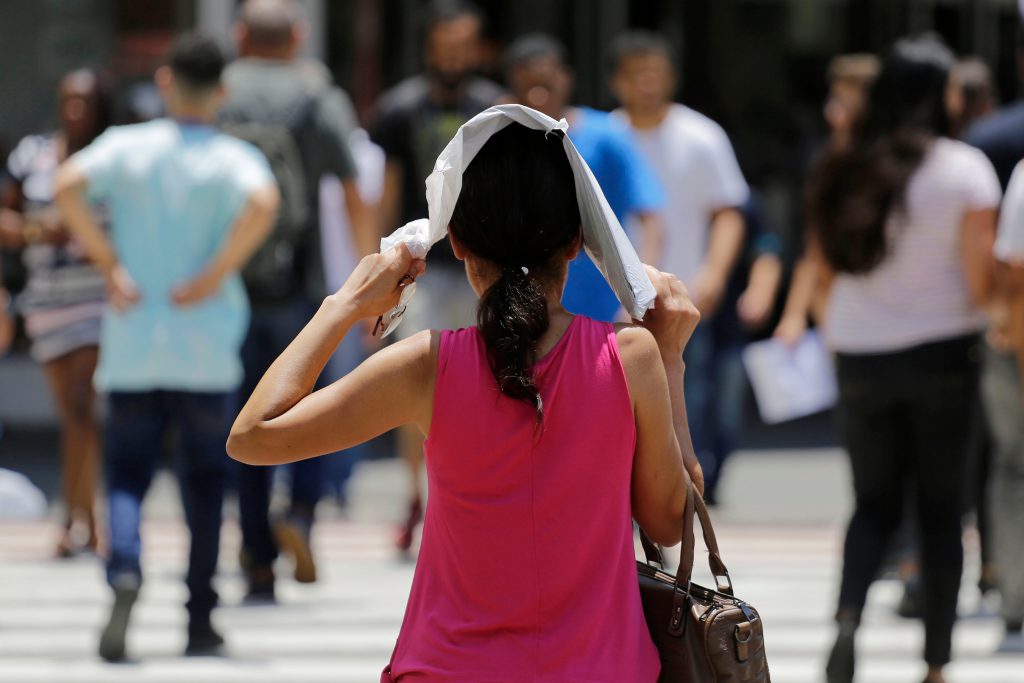
Much can be done to prevent and tackle this problem. Numerous calls by international organizations, and our in-depth articles addressing this issue, argue that progressive actions need to be taken to redesign urban areas, reduce reliance on car centre transport systems (with heat-absorbing asphalt and concrete), and raise public awareness about the dangers of heat.
In addition, to mitigate the health risks associated with heat, there is a need for a change of behaviour during warm days. That means that individuals should prioritize staying hydrated, seeking shade, and limiting strenuous activity during periods of high temperature. These recommendations are supported by leading health organizations like the World Health Organization (WHO), the Centers for Disease Control and Prevention (CDC), and The Public Health Agency of Sweden, Folkhälsomyndigheten.
The social and psychological dynamics of urban heat stress mitigation
Implementing changes in urban planning and new technologies, such as the microclimates discussed in our article, to address the problems of climate change can be met with public resistance, hindering progress. The challenges of raising awareness about the heat stress risks and fostering changes to tackle the wicked problems caused by a warmer planet are multifaceted, involving factors such as infrastructure, low public awareness of the problem, a variety of individual perceptions, and more. This article will explore some of these factors, including the understanding that shifting planning, cultural norms, and individual behaviours is a gradual process, rather than an immediate event. Even under optimal conditions, altering deeply ingrained attitudes and practices can be more demanding than anticipated.
While political actors and technological advancements play crucial roles in mitigating this issue, the needs of individuals, their beliefs, their expectations and their behaviours are of vital importance too. Understanding how individuals perceive the dangers of heatwaves, their motivations for adopting mitigation and adaptation behaviours, and the potential impacts on their well-being and health is essential for developing effective strategies. Numerous factors influence people’s decisions, behaviours and acceptance of change, yet these are important as they ultimately drive societal change in tandem with new planning practices and policies.
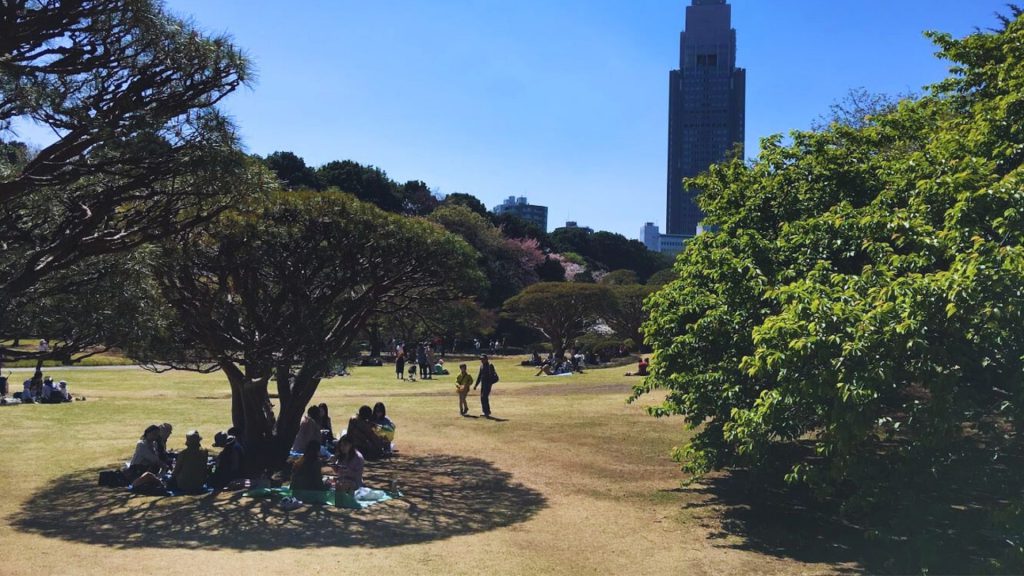
The Benign project – to tackle urban heat
In the Netherlands, Zahra Khosravipoor, a PhD student in Landscape Architecture at Wageningen University, is working on the transdisciplinary project BENIGN—Blue and Green Infrastructure Designed to Beat Urban Heat. Her research group is collaborating with residents, municipalities, and health authorities to find ways to adapt cities to the warming climate. They are developing a decision support system (DSS) for Dutch municipalities to overcome challenges and help them make optimal decisions by identifying effective green and blue space interventions.
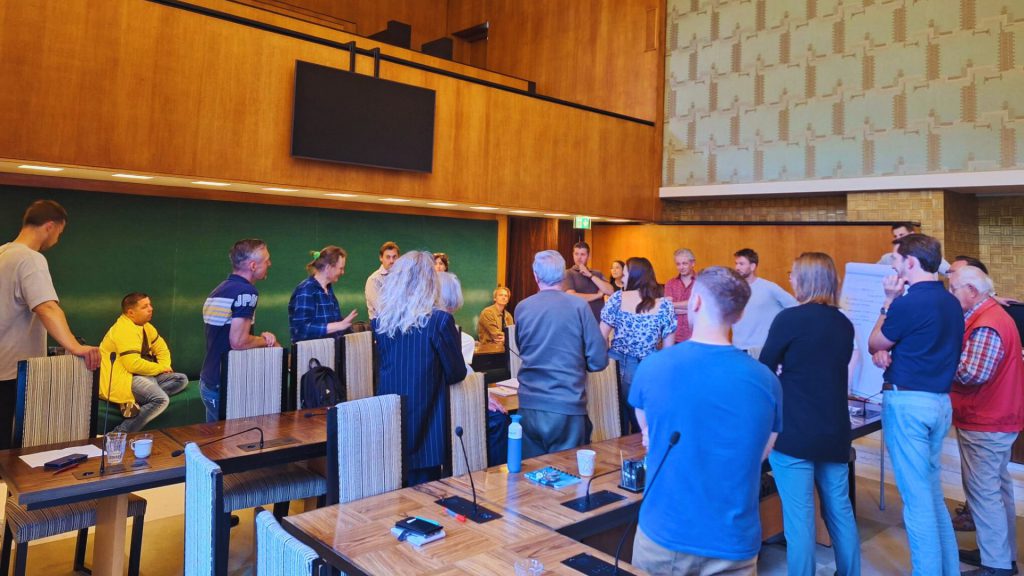
Photo: Zahra Khosravipoor
Communication and long-term commitment to cultural and behavioural changes
Zahra Khosravipoor emphasized the need for a broad approach to raise heatwave awareness and promote acceptance of the problem and behavioural changes, stressing the roles of personal relevance, social norms, media communication, and community engagement.
Khosravipoor noted, “cultural and behavioural changes take time to materialize,” emphasizing the need for patience and long-term commitment in addressing these issues.
“One of the main barriers here is the lack of awareness, especially for people living in the northern countries. They have just limited warm or hot days (consecutive days with temperatures above 25 °C). Because of this, individuals are unable to comprehend the potential risk posed by the heat and believe that they are safe from it.”
“This can also be made worse by misinterpreting the heat as a result of insufficient exposure to extremely high temperatures. It provides them a nice summer feeling, especially in the Nordic countries where frigid weather prevails for much of the year, and therefore they are not aware of the numerous changes it will bring to their body’s physiology”, she explains.
Zahra identified several social obstacles to effectively communicate the dangers of heat to the public:
There are individuals who are aware of the heat warnings. However, they would rather not take them seriously, as they fear embarrassment from others. Some social norms can be obstacles that lead to ignoring the warnings and preventing people from taking action.
– Zahra Khosravipoor
“Furthermore, there are accessibility obstacles, which means that even though people are aware of the risks and have overcome the social norms, they are unable to physically or financially access cool places either within their homes or outside in the neighbourhood. What can they do when their houses are not designed suitably to let hot air escape naturally or without any access to a cool spot nearby?”
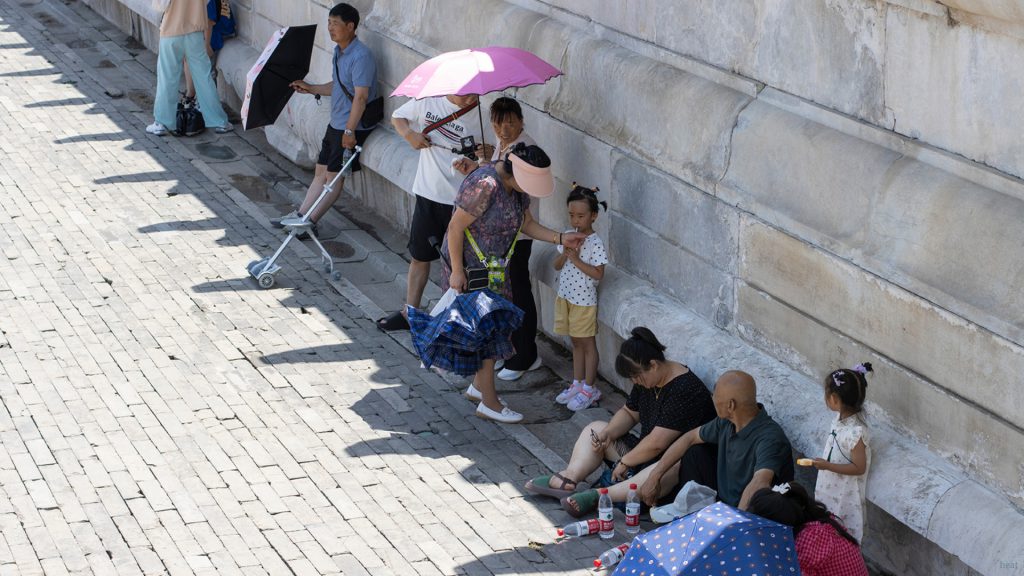
Finally, Zahra talks about the problem she calls blame-shifting. “Even when you have overcome all other obstacles, you believe that the government or municipalities ought to handle the situation and take action instead of you. As a result, there won’t be any small steps to start that shift.”, she explains.
Challenges in Infrastructure – Implementing Urban Heat Island Mitigations
The under-prioritization of heat-related issues in urban planning often hampers the implementation of green space initiatives, as these initiatives require substantial changes in infrastructure and resource allocation.
According to Zahra´s research, a significant barrier to creating more green spaces is the scarcity of urban land and the need to systematically change urban planning. “To make room for these plantations, we need significant changes in land-use plans. Additionally, urban infrastructure also needs to be significantly modified to provide the right growth environment for plants with less damage from the plantation programs.” In our article series, we have discussed how on and under-the-ground space needs to be created to tackle the urban heat stress problem.
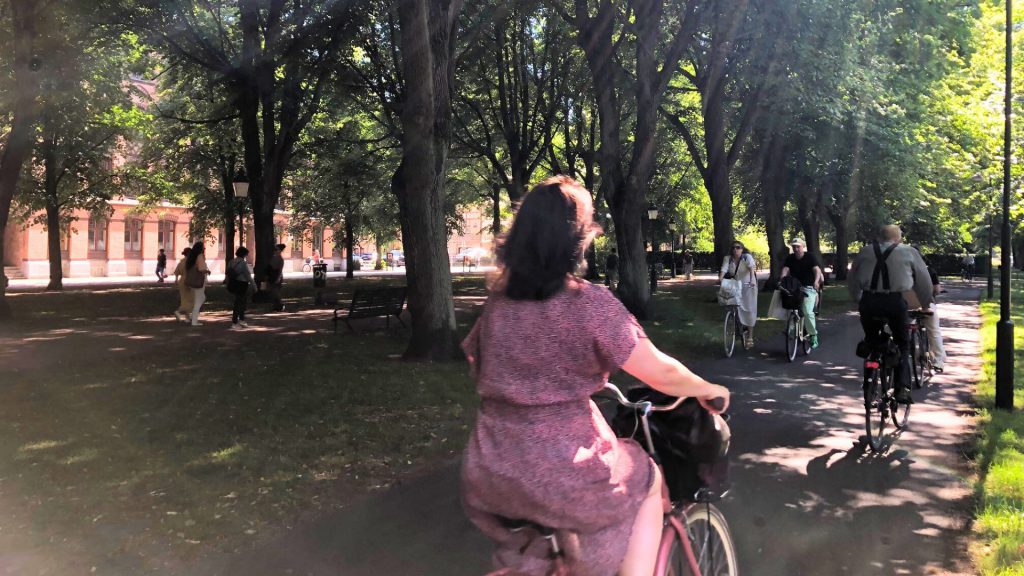
However, even if cities are able to allocate sufficient land for green spaces, there are additional long-term commitments to tackle the heat issue.
“Moreover, green and blue spaces need long-term maintenance considerations for proper functioning. Implementation and maintaining these interventions require long-term investment and will cause significant financial challenges for municipalities or other responsible organizations. Due to the unpredictability of urban heat and the lack of long-term accurate projections to predict its variations, our interventions need to be adaptive and flexible to respond to upcoming events. Additionally, working with natural and water components necessitate a thorough understanding of how they behave at different times.”, Zarah explained, highlighting how these materials could retain or relieve heat at different conditions.
Green roofs and walls as other nature-based solutions also face obstacles going beyond maintenance challenges, including a lack of incentives for property owners, and heritage building regulations, as she explains.
“The incorporation of urban green spaces also intensifies the confrontation with other urban, such as the housing crisis. Therefore, it is necessary to prioritize the urban problems and predict other upcoming challenges, since there is no certainty that our sustainable interventions won’t cause any gentrification or other future issues for cities”, Zarah stated.
Adaptive and flexible solutions for urban planning – a living lab approach
To address some of these challenges, Zahra advocates co-creation processes with citizens in urban development projects, which can be promising to tackle challenges and foster sustainable practices locally.
“Involving citizens in urban projects may be a promising solution for municipalities in order to overcome some of the mentioned challenges, as doing so can be advantageous for both parties. As we attempt to achieve it in the BENIGN project with living labs, residents are invited to participate in projects to be more aware of the possible actions through workshops, co-design sessions, and interactive programs and communicate their needs and wills. To increase the incentives to adopt sustainable practices, they might also be combined with financial incentives like tax breaks and subsidies”, she explains.
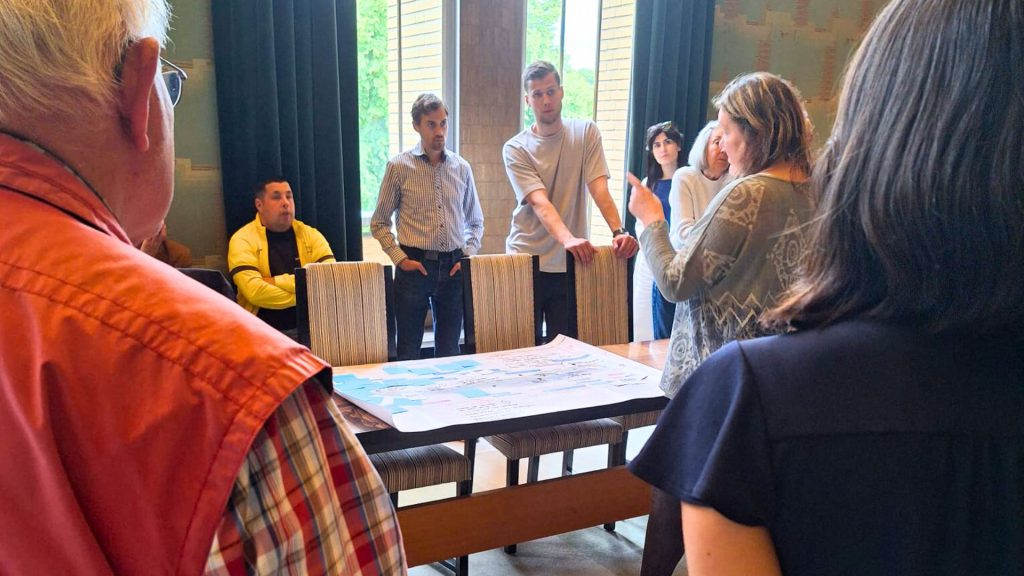
Living Laboratories offer a welcome approach for change management and knowledge co-creation to influence sustainable futures. While living labs take many forms and are defined in different ways, they always reflect an interest in open research environments that explore society-science interfaces in real-time.
Ensuring Democratic Access to Information and Communication
Kristina Blennow, Professor of Landscape Planning at SLU, researches risk assessment, management, and communication in landscape planning. Her research integrates climate impact knowledge into urban planning, with a particular emphasis on developing effective communication strategies for extreme weather events, such as heatwaves, and a gradually changing climate.
In the interview, Kristina discusses how her background as a climatologist shapes her approach to understanding these phenomena. Further, she has discussed how longstanding interdisciplinary collaboration with the philosophers Johannes Persson and Erik Persson at Lund University has led her to study how to develop effective communications that integrate scientific knowledge, such as estimates of probabilities and impacts with the experiential knowledge of inhabitants and practitioners, and also how to elicit the inhabitants’ values.
“In a democracy, everyone should have the opportunity to make informed decisions. Our goal is to identify the communication needs of various groups in society,” Blennow explains.
By understanding the driving forces behind people’s decisions, we can tailor our communications, aiming to integrate local experiential knowledge with scientific knowledge to enable proactive measures at both personal and community levels.
– Kristina Blennow
Her research explores the decision-making of individuals and communities regarding adaptation and environmental change. “My current research aims to identify the communication needs of different groups of people,” she notes, stressing the importance of understanding what people know about the phenomena of urban heat stress and what they need to know to make informed decisions.
Blennow emphasizes the need for targeted communication strategies to empower various groups to make informed decisions.
“Communications must meet the recipient’s needs to be effective in helping those people make better decisions from their own perspective,” she added. Her research highlights the necessity of such strategies to ensure that people have the information they need to take appropriate actions, seek support, and contribute effectively to community efforts.
Protecting Our Communities: The Importance of Climate Education and Action
Kristina Blennow emphasizes the importance of integrating interdisciplinary climate expertise into urban planning, spanning from architecture and urban design to broader societal values, including health care.
“We teach at SLU about integrating various aspects into city planning, such as architecture and urban design, to mitigate heat effects. However, much more is needed. I believe that it is not just landscape architects who need to understand this, with society as a whole needs to value it more, particularly in protecting communities. This includes both reducing greenhouse gas emissions and adapting to climate changes. These understandings are needed at all levels, including among the general public, as it all ties together.”
Blennow advocates for a more comprehensive approach to addressing heatwaves, emphasizing the need for education and training in, for example, elderly care. “It’s crucial that everyone, including vulnerable populations, like the elderly, and the health personnel working with them, has access to the information they need to protect themselves and the elderly during heatwaves,” she says.

Supporting decision-making by detecting underlying end values
Kristina Blennow’s research group has developed a tool called DeveLoP—A Rationale and Toolbox for Democratic Landscape Planning, which is designed to gather the necessary information to identify knowledgeneeds and understand what goals and values people hold.
“When planning in a city, for instance, vulnerability assessments often focus on infrastructure and expensive facilities. However, we have tried to identify what values the residents place on their surroundings and have incorporated means for eliciting this into our tool. It describes how we have developed a new valuation tool that goes beyond monetary values, looking instead at what are called ‘end values’ or ultimate goals.”
“This allows us to understand what people truly value, beyond instrumental values, such as the economy, although monetary values are also included. For some people, money is a significant value, but for most, it is just a means to an end. By using our tool, we can dig deeper to understand why certain places are important to individuals.”
Kristina Blennow emphasized the importance of understanding the local and contextual significance of places when redesigning or changing spaces. She warned against overlooking the values that hold personal or community importance. “You can’t determine why people value a place or if they have memories or historical associations with it just by examining the physical landscape,” she explained. “Values are subjective and reside within the people. You have to ask them to know.”
“In another interdisciplinary study, we developed an evaluation tool for places, and we used an interactive map where people could select the most important place for them, followed by a series of questions regarding culture, identity, community cohesion and sense of place. I believe a lot of this comes down to the knowledge gap we see in many of our studies—there are often misunderstandings. If any part of the chain misunderstands something, it can lead to poor outcomes,” Blennow explained.
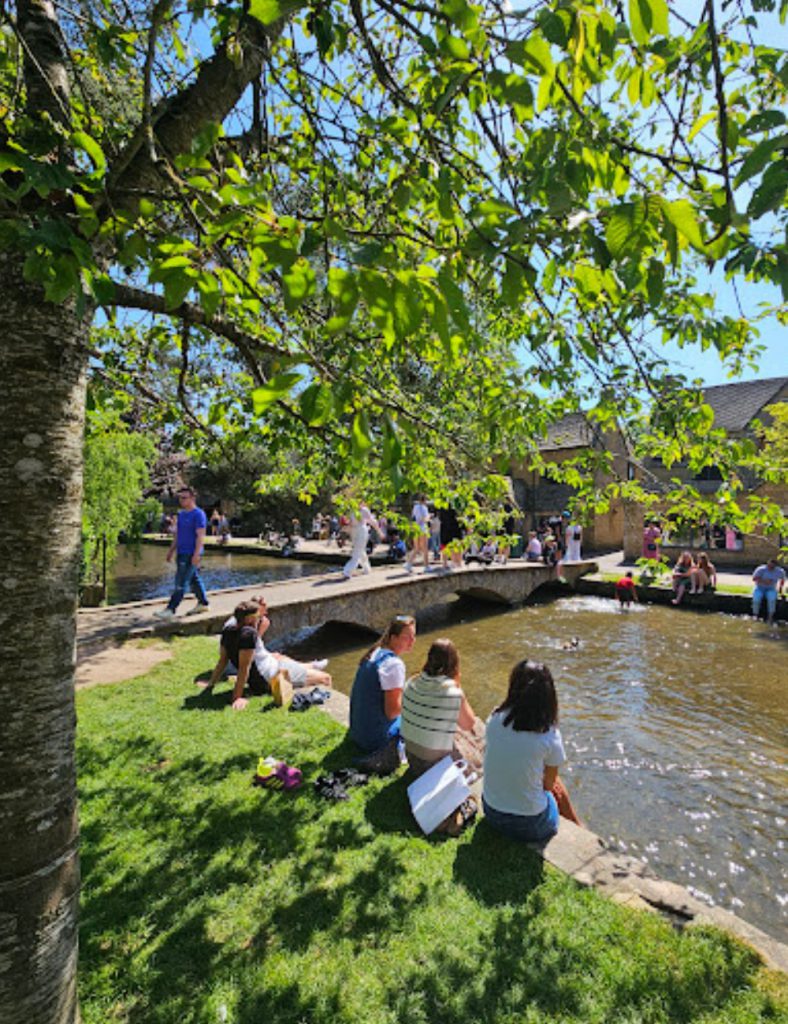
Understanding Motivations for Climate Action: Insights from Malmö’s Heat Wave Research
By understanding how individuals connect their personal narratives to the broader issue of climate change, policymakers can develop strategies that are more effective for engaging citizens in climate action. Kristina shared that what a person expects climate change to result in is important for their decision-making.
In a project conducted in Malmö as part of the course Climate Change – Landscape in Transition, students explored the relationship between personal experiences, climate change perceptions, and behavioural responses among Malmö residents.
“Our findings reveal a nuanced connection between personal experiences and climate change perceptions. Individuals who believe they have personally experienced climate change effects, such as heat waves or extreme weather events, are more likely to prioritize adaptation measures. However, the significance of these experiences extends beyond mere occurrence. The attribution of such events to climate change plays a pivotal role in shaping individuals’ motivations”.
“If a person perceives a negative event as being caused or exacerbated by climate change, their drive to adapt is significantly amplified. For instance, a resident who experiences a severe heat wave and attributes it to rising global temperatures is more likely to support measures like urban greening or energy-efficient building practices.”, she explains.
“When it comes to climate change mitigation, the relationship between personal experience and motivation is more complex. Residents who have experienced negative climate change impacts are more likely to support greenhouse gas emission reduction measures. However, those who perceive positive impacts may be less motivated to mitigate climate change.”, Blennow explains.
This research underscores the importance of personal experiences coupled with scientific knowledge in forming a belief in the local impacts of climate change and shaping public action on climate change.
Opposition to development projects: The “Not in my backyard” Phenomenon
To combat urban heat islands and make our cities cooler, we must reduce car traffic and implement city planning strategies that prioritize green spaces and sustainable transportation. Psychological research can inform our understanding of the ‘not in my backyard’ (NIMBY) phenomenon, which often arises in response to proposed changes in local communities.
Low-traffic neighbourhoods (LTNs) and car-free streets, which can reduce heat emissions, pollution and noise, are polemic topics. Understanding the broader roles of urban spaces for people´s needs and the quality of life that we aim to change is important. Previous research has shown that simply addressing the factors people say they want to address, like adding more bike lanes, is not enough to change behaviour or increase cycling. Studies have shown that controversy and resistance arise when place identity and place attachment are perceived to be threatened by proposed changes, discouraging acceptance of changes in these initiatives.
As argued by research in spatial disciplines, the social sciences, and environmental psychology, because cars and places symbolize status and provide personal security, there is a need to continue understanding these personal functions which form barriers to change acceptance, with attention to details and nuances of individual cases.

“Acceptance can be difficult”- gradual change is key
Elizabeth Marcheschi, Lecturer in Environmental Psychology at SLU, has researched the human-environment experiences of place, including projects about car-free street interventions. Her background in Clinical and Community Psychology has shaped lenses that enable her to work in various field studies, focusing on the need for comprehensive engagement strategies that address various levels of environmental analysis, from policymakers to end users.
Elizabeth offers a thoughtful perspective on the challenges and opportunities of implementing sustainable urban changes. She emphasizes the importance of gradual and adaptive approaches that consider the human element.
“Acceptance can be difficult,” she explains, “especially when changes disrupt our daily routines. People are often more receptive to pro-environmental changes when they don’t directly impact their immediate environment.” However, she notes that humans are adaptable and can benefit from gradual changes that allow for a gradual shift in their experience of place, mobility, and quality of life.
“Gradual change, supported by monitoring and co-creation through transdisciplinary investigations, is key,” Elizabeth says. “By considering all units of environmental analysis, we can better understand the complex systemic changes involved in creating a more sustainable society.” These would entail understanding both the physical and psychosocial connections with places.
Integrating People’s Relationships with Place in Car-Free Street Planning
She explains that a challenge in planning practices that involve place change is overlooking the crucial role played by place users. People’s experiences are essential for driving a shift in a place that will be accepted and well included in people´s lives. To ensure successful planning changes, ongoing dialogue is necessary to support informed decision-making that addresses diverse contextual conditions and the needs of all users, including intangible relational needs that significantly shape the overall atmosphere of a place:
Elizabeth highlights the use of “summer streets” in Scandinavia as an example of a gradual change that has the potential to become permanent. She emphasizes the importance of monitoring not only functional aspects like behaviours but also the emotional and relational aspects of people’s connection to place.
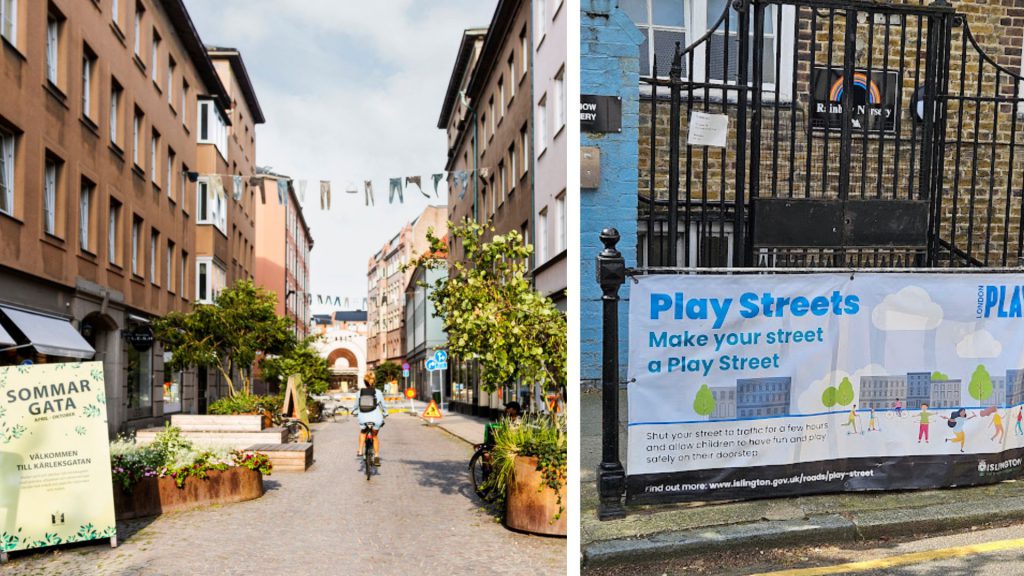
A key aspect is to frame interventions, such as car-free street experiments, within the wider transition context of systemic change – to enable different stakeholders to work across sectors and disciplines, to then be able to effectively communicate co-creating with all relevant social actors involved.
– Elizabeth Marcheschi
A recent transdisciplinary research project on a car-free intervention in Sweden focused on the intersection of mobility patterns, social inclusion, and environmental sustainability, with other researchers from SLU, such as Nina Vogel and Anders Larsson. Elizabeth highlights the importance of integrating car-free street experiments within a broader context of systemic change:
“In order to implement meaningful measures, at suitable locations, with a thought-through process of outreach, communication and engagement there is a need to consider every unit of environmental analysis from policymakers to final users. Thus, a key aspect is to frame interventions, such as car-free street experiments, within the wider transition context of systemic change – to enable different stakeholders to work across sectors and disciplines, to then be able to effectively communicate co-creating with all relevant social actors involved. This includes the final users of place”, she explains.
“From our work, we observed that there is no single effective strategy for communication and implementation. Instead, different approaches are necessary depending on people’s relationships with the place and overall quality of life assessment. This highlights the importance of monitoring the situation before, during, and after planned interventions, especially considering the interplay between mobility and attachment when discussing car-free streets and neighbourhoods,” Marcheschi explained.
She referenced a framework proposed by Di Maso and others as a potential starting point for dialogue with the public and residents. This framework, which examines the balance between “fixity and flow,” provides a way to have an open dialogue to transform potential resistance to change into new opportunities related to attachment, identification with place, and mobility patterns:
“What such framework can offer is information and data for an open dialogue about how place-change provides opportunities for people change. Where concepts such as complementary compensation, overarching integration and multi-centre integration, between the needs of feeling safe, and rooted in an immediate neighbourhood, and experiencing a sense of continuity across environmental types at a similar geographic scale, can be put forward and explored together“ she suggested. Marcheschi also advocates for a place-specific dialogue that takes into account socio-economic context, local cultural conditions, ethnicity, and political climate. She suggests shifting from a static view of place to a fluid one, where place-based changes are seen as part of a larger vision that connects various environments. By expanding the notions of attachment and identity to include a wider range of spaces, she argues that we can foster a more sustainable and healthy way of life.

How to proceed from here
Redesigning urban spaces to better cope with heatwaves, raise awareness of urban heat dangers, and promote sustainable behaviours presents significant challenges but is crucial for a sustainable and equitable future. Addressing these challenges requires a multifaceted approach, considering various factors that influence people’s willingness to adapt and accept changes.
Firstly, it is essential to recognise that heat waves impact not only physical comfort but also broader health aspects. These effects are particularly dangerous for certain populations, such as the elderly and those in northern regions unaccustomed to heat, as discussed in this article and the piece titled “Extreme Urban Heat – A Serious Threat in Cities and a Contemporary Health Hazard.” People may not immediately realise how their environment affects their ability to cope with heat, making it crucial to provide timely and targeted information on heat resilience strategies.
Secondly, heatwaves and their associated dangers are emerging social problems that present new cognitive and cultural challenges. Research indicates that it is challenging for people to grasp threats that are invisible, long-term, and widespread, such as heat waves resulting from climate change. Simple awareness campaigns may not be sufficient to prompt significant changes in behaviour, expectations, or acceptability. More targeted approaches are necessary, including identifying communication needs, monitoring various factors and groups involved in interventions, and addressing the challenges of implementing changes.
Addressing urban heat island effects requires interdisciplinary collaboration. Transdisciplinary research plays a vital role by illuminating how people perceive and respond to change. It informs the design of interventions that align with human behaviour and preferences. By integrating psychological insights with practical urban design, cities can develop more effective strategies to enhance resilience and sustainability. This article is built under the concept of Urban Healthscapes, aiming to incorporate interdisciplinary perspectives and collaborative efforts to connect crisis communication with urban planning, thereby supporting public health through thoughtful public space development.
References
Read our other article in the series:
Extreme urban heat – a serious threat in cities and a contemporary health hazard
Journal Articles:
- Blennow, K., Persson, E., & Persson, J. (2019). Are values related to culture, identity, community cohesion and sense of place the values most vulnerable to climate change? PLOS ONE, 14 http://doi: 10.1371/journal.pone.0210426
- Blennow, K., Persson, E., & Persson, J. (2021). DeveLoP – a rationale and toolbox for Democratic Landscape Planning. Sustainability, 13, 12055. https://doi.org/10.3390/su132112055.
- Blennow, K., & Persson, J. (2021). To Mitigate or Adapt? Explaining Why Citizens Responding to Climate Change Favour the Former. Land, 10, 240. https://doi.org/10.3390/land10030240.
- Marcheschi, E., Vogel, N., Larsson, A., Perander, S., & Koglin, T. (2022). Residents’ acceptance towards car-free street experiments: Focus on perceived quality of life and neighborhood attachment. Transportation Research Interdisciplinary Perspectives, 14, 100585. http://dx.doi.org/10.1016/j.trip.2022.100585.
- Prashant Kumar, S. E. Debele, S. Khalili, C. H. Halios, J. Sahani, N. Aghamohammadi, M. de Fatima Andrade, M. Athanassiadou, K. Bhui, N. Calvillo, S.-J. Cao, F. Coulon, J. L. Edmondson, D. Fletcher, E. Dias de Freitas, H. Guo, M. C. Hort, M. Katti, T. Rodding Kjeldsen, S. Lehmann, G. Maselli Locosselli, S. K. Malham, L. Morawska, R. Parajuli, C. D. F. Rogers, R. Yao, F. Wang, J. Wenk, L. Jones. (2024). Urban heat mitigation by green and blue infrastructure: Drivers, effectiveness, and future needs. The Innovation, 5(2). https://doi.org/10.1016/j.xinn.2024.100588.
Final Project:
- Ulinder, E., & Nilsson, E. (n.d.). The Climate Resilient City of the Future. Swedish University of Agricultural Sciences (SLU). At the Swedish University of Agricultural Sciences (SLU), Elin Ulinder and Ellinor Nilsson wrote a final project on The Climate Resilient City of the Future, with a particular emphasis on urban heat in the city of Malmö. Their research highlighted the significant challenge of developing clear and effective policies and creation of awareness for climate change adaptation, particularly given the fact that private property owners play a crucial role. They observed that the Malmö municipality owns only about 30% or less of the property within the city, making the involvement of private property owners essential for successful climate adaptation efforts.
Additional research
- Jiao A, Sun Y, Avila C, et al. Analysis of Heat Exposure During Pregnancy and Severe Maternal Morbidity. JAMA Netw Open.2023;6(9):e2332780. doi:10.1001/jamanetworkopen.2023.32780
- Guo C, Ge E, Lee S, Lu Y, Bassill NP, Zhang N, Zhang W, Lu Y, Hu Y, Chakraborty J, Emeny RT, Zhang K. Impact of heat on emergency hospital admission in Texas: geographic and racial/ethnic disparities. J Expo Sci Environ Epidemiol. 2023 Aug 9. doi: 10.1038/s41370-023-00590-6. Epub ahead of print. PMID: 37558698.
- Kiarsi M, Amiresmaili M, Mahmoodi MR, Farahmandnia H, Nakhaee N, Zareiyan A, Aghababaeian H. Heat waves and adaptation: A global systematic review. J Therm Biol. 2023 Aug;116:103588. doi: 10.1016/j.jtherbio.2023.103588. Epub 2023 Jul 16. PMID: 37499408.
- Xu R, Huang S, Shi C, Wang R, Liu T, Li Y, Zheng Y, Lv Z, Wei J, Sun H, Liu Y. Extreme Temperature Events, Fine Particulate Matter, and Myocardial Infarction Mortality. Circulation. 2023 Jul 25;148(4):312-323. doi: 10.1161/CIRCULATIONAHA.122.063504. Epub 2023 Jul 24. PMID: 37486993.
- Wen J, Zou L, Jiang Z, Li Y, Tao J, Liu Y, Fu W, Bai X, Mao J. Association between ambient temperature and risk of stroke morbidity and mortality: A systematic review and meta-analysis. Brain Behav. 2023 Jul;13(7):e3078. doi: 10.1002/brb3.3078. Epub 2023 Jun 2. PMID: 37269140; PMCID: PMC10338745.
- Heat and health inequity: acting on determinants of health to promote heat justice
Jeremy Hess. Nature Reviews Nephrology, January 2023. - Urban extreme heat, climate change, and saving lives: Lessons from Washington state
Zachary Kearl and Jason Vogel, Urban Climate, January 2023. - Heat and air quality related cause-based elderly mortalities and emergency visits
Mohamed Dardir, Jeffrey Wilson and Umberto Berardi. Environmental Research, January 2023. - Associations between high ambient temperatures and heat waves with mental health outcomes: a systematic review
R. Thompson, et al. Public Health, August 2018. - Differences in Heat-Related Mortality by Citizenship Status: United States, 2005-2014
Ethel V. Taylor, et al. American Journal of Public Health, April 2018.
Share
Co-creation!
Do you miss something here? Would you like to contribute? Please let us know: urbanfutures@slu.se



